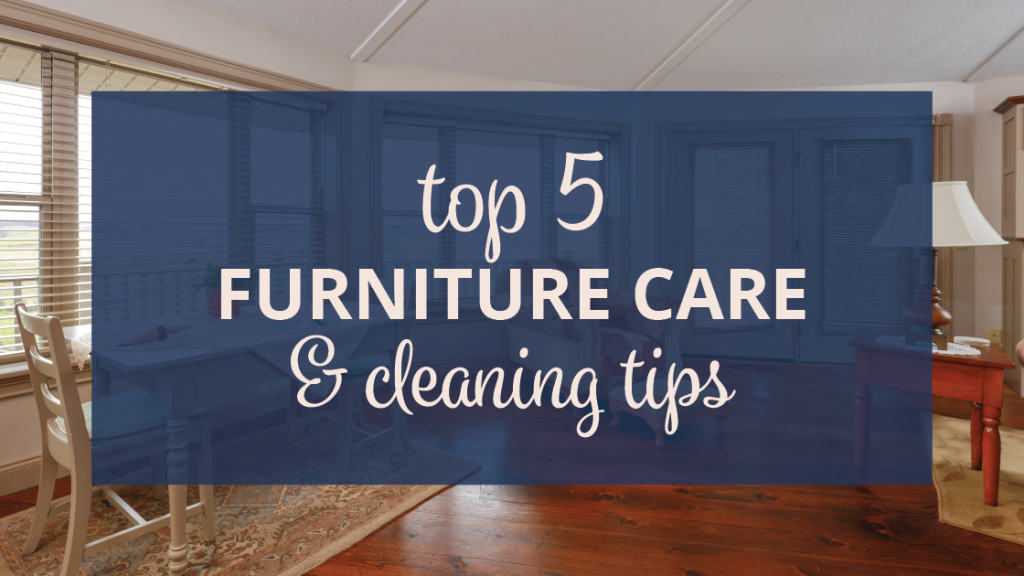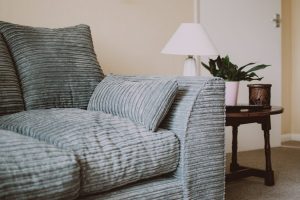Top 5 Furniture Care and Cleaning Tips

One reason people buy inexpensive plastic and laminate furniture is because it’s easy to clean and care for. Spills, dust, and stains are taken care of with a simple wipe. People think of solid wood furniture as difficult to maintain and hard to care for, but learning how to clean solid wood furniture is simpler than you might think.
The truth, though, is that hardwood furniture doesn’t require the white glove treatment to keep it looking its best for years. With some basic routine care, your wood furniture will last longer and retain its beauty far better than lower-quality materials.
1. Focus on Prevention
The first step to keeping your wood furniture clean is the easiest – it actually doesn’t require any work at all. Protecting your wood furniture from stains, scratches, and grime is the simplest way to keep it looking its best. Basic prevention can keep you from ever having to worry about refinishing or restoring your wood furniture.
Moisture and spills are the greatest threats to the beauty of your hardwood. Luckily, these common causes of damage are the easiest to prevent. One of the most often seen forms of damage is water rings. The condensation that accumulates on the bottom of a cold drink collects on the furniture’s surface, leading to damage. Those familiar white rings are caused by the water interacting with the finish, while darker rings are a sign that the moisture has penetrated this finish to stain the wood itself. Preventing water rings is as simple as using a coaster so the moisture rests on it instead of the wood surface.

Your dining table may be affected by the same process. Hot plates and cold drinks can discolor and stain wood over time. Condensation, spills, and steam can leave your table looking worn and dull. A simple placemat or tablecloth is the easiest way to prevent this issue. Like coasters, they help to prevent liquids from sitting on the wood’s surface. Fabric placemats and tablecloths are also easy to clean and can be changed seasonally for an instant update to your kitchen decor. A trivet placed underneath hot dishes further protects wood from discoloration.
Choosing the right protector for your wood surfaces is as important as using one to begin with. While stone and tile coasters may be attractive, it’s important to use a soft material to prevent scratching. Look for coasters backed with soft felt or natural cork to protect surfaces from both scratches and water damage. In the kitchen, use a durable trivet with rubber feet or a cork backing to prevent slipping and scratching.
Scratch prevention includes everything you place on your wood surfaces, it’s not just limited to food and drinks. Place cloth pads or felt feet underneath lamps, electronics, bookends, and other heavy accessories. Use a writing pad to prevent pens from marking your desk. The addition of these simple protections will keep your wood looking its best for years to come.
2. Dust Your Wood Furniture
Of course, prevention doesn’t do everything. Dust still shows up on surfaces in your home. Dust seems like a minor nuisance, but for your wood furniture it can actually cause damage over time. Those fine particles can lead to scratches so small you might not even see them. However, over long periods, thousands of tiny little scratches and scuffs caused by dust can make your furniture look worn. Dust will act like an exfoliator or very fine sandpaper, gradually damaging the protective finish and exposing the wood to greater harm.
Regular dusting is essential to keep your wood furniture looking new. Not only does routine dusting keep surfaces visibly clean and reduce allergens in your home, but it also protects your wood from those tiny scratches.
Before you reach for a can of dusting spray, though, you should know the best tools for dusting wood furniture. Feather dusters, for example, are great for delicate collectibles but don’t trap the dust. Using a feather duster only spreads dust particles from one spot to another, leaving them to eventually settle back on your furniture. A lambswool duster is a better alternative. The lanolin oils in wool naturally attract and hold dust particles, keeping them from resettling on your wood.
Cloth is an even better alternative, but not all cloth is the same. Microfiber dusting cloths are the best solution for removing dust from your furniture. Microfiber is soft enough to not cause any additional damage to the surfaces. These cloths are also made to trap and hold dust and fine debris. Microfiber can be disposed of or washed and re-used. And if you find any stubborn grime while dusting, microfiber is designed to be lightly dampened so you can wipe tougher spots without excessive, damage-causing water.
3. Know the Best Products for Cleaning Solid Wood
When you do have more stubborn grime on your furniture, it’s important to know the best way to clean it. Simply dusting won’t remove oils or sticky spots. Regular washing is an important part of wood maintenance. Even minor messes like fingerprint smudges aren’t just unsightly – they also contain oils and moisture that can harm wood surfaces and accumulate abrasive dust.
 Just like dusting, though, it’s important to have the right tools for the job. While cleaning products have many household uses, the chemicals in them can actually harm natural wood. All-purpose cleaners and dusting sprays should be avoided, especially as your wood furniture ages. Residue and chemical interactions can leave wood finishes sticky. Worse, the wrong chemicals can, in time, strip away your wood’s finish and lead to permanent damage. Many products marketed as wood cleaners contain silicon solvents that can damage finishes. A simple damp microfiber cloth is a good place to start to avoid unnecessary chemicals and excessive moisture. Use light pressure to scrub and you can remove many messes in a matter of seconds.
Just like dusting, though, it’s important to have the right tools for the job. While cleaning products have many household uses, the chemicals in them can actually harm natural wood. All-purpose cleaners and dusting sprays should be avoided, especially as your wood furniture ages. Residue and chemical interactions can leave wood finishes sticky. Worse, the wrong chemicals can, in time, strip away your wood’s finish and lead to permanent damage. Many products marketed as wood cleaners contain silicon solvents that can damage finishes. A simple damp microfiber cloth is a good place to start to avoid unnecessary chemicals and excessive moisture. Use light pressure to scrub and you can remove many messes in a matter of seconds.
For tougher messes, the best solution is also sometimes the simplest. Basic soap and water is safer for wood surfaces and will remove most regular household messes easily. Cleaning experts recommend a gentle dish soap to cut through oils and grime without damage. Dish soap can also be easily rinsed away, avoiding the damaging buildup than many all-purpose cleaners can leave behind. It’s important to fully dry wood surfaces after using soap and water, though, to avoid water marks and discoloration. Use a soft towel or microfiber to remove lingering moisture.
There may come a time, however, when a deeper clean is necessary. There are still steps you can take to avoid chemical damage to your furniture when the time comes.
It’s a good idea to spot test any cleaner or soap you use before applying it to your whole piece. Use a cotton ball or microfiber cloth to test a small, out of sight area first. This allows you to see if there is any discoloration or damage to the finish. When you’ve determined if the cleaner is safe for your wood, work in small areas at a time. This keeps cleaners and water from sitting on surfaces longer than needed. If using a spray cleaner, spray it on your cloth instead of directly onto the wood itself. When using liquid, always wring out your cloth well. When learning how to clean solid wood furniture, cleaning cloths should be damp, not dripping wet, to avoid the possibility of water damage.
4. Don’t Neglect Non-Wood Surfaces
Of course, many pieces of furniture aren’t exclusively made of wood. Keeping your furniture in peak condition also means cleaning and maintaining other surfaces with care.

Upholstered chairs and sofas can’t be dusted like solid wood. For removing everyday debris, the best option is regular vacuuming. Using a brush attachment or small handheld vacuum keeps fabric clean. For ground-in dirt or spills, however, an upholstery cleaner is sometimes necessary. As with cleaning wood, you want to test on an inconspicuous area first to be sure the cleaner won’t stain or cause the color to bleed. While cleaning upholstery, it’s a good idea to protect wooden arms and legs from possible damage as well. Cover these surfaces while you work and be sure to immediately remove any cleaners that drip onto the wood.
For leather seats, conditioning once or twice a year will keep the surface supple and smooth. Regular conditioning helps to prevent cracking and discoloration. Like wood, leather can be damaged by excessive water and moisture. If you spill anything on your leather seat, quickly dry the area with a soft, absorbent cloth. Avoid using soap or chemical cleaners as these can damage leather surfaces.
Many pieces of office, kitchen, and living room furniture have metal hardware. Handles and knobs are touched and moved often, making them some of the most important parts of your furniture to clean. The best way to clean these pieces is to remove the hardware. This not only makes it easier to clean, but also protects the wood around it from damage. Use caution when doing so to avoid scratching furniture. Always use a cleaner specific to the type of metal. If you’re unsure of the metal, a solution of equal parts acetone and rubbing alcohol is recommended. Always be sure to thoroughly dry metal hardware before reattaching it to avoid water damage to the wood around it.
Glass panels in shelving and cabinets show fingerprints and smudges well, so it’s important to clean these often. A vinegar-based glass cleaner is safer to use around wood surfaces than ammonia or other chemicals. When cleaning glass, remember to quickly remove spray from the surrounding wood as well.
5. Maintain a Regular Cleaning Schedule
The best way to keep your wood furniture clean is to stick to a regular schedule. Making furniture care part of your regular household routine ensures that it will last for years to come.
Some aspects of cleaning depend on your lifestyle and how often you use a specific piece of furniture. A favorite reading chair will see more use, and more mess, than an occasional guest bed. If you have pets, you may need to dust more regularly to keep up with fur and dander. Any cleaning schedule is a good guideline, but you should make adjustments as needed to fit your home and family.
Kitchen and dining tables should be wiped down daily to remove food residue. These frequently-used surfaces also require regular, deep cleaning with soap and water, especially if you don’t use a full tablecloth.
Dusting should be done weekly to avoid accumulation. Tablecloths and placemats should also be washed weekly to keep them free of dust or debris that can transfer to the wood beneath. A deeper cleaning with soap (or a safe furniture polish) should be done monthly for items that you use often, but can be done every other month for furniture that doesn’t see as much use. This deeper cleaning is also a good time to check that protective measures, like felt pads, are in good condition.

Whether you’re looking for your next bedroom set, or a sturdy dining room table for your growing family, we want to make sure you know how to clean solid wood furniture so you can enjoy the furniture we make here at AmishOutletStore.com for years to come.
With proper protective measures and regular cleaning, solid wood furniture can truly last a lifetime. Making simple cleaning techniques a part of your family’s schedule makes it easy to keep your wood looking its best, even years after you’ve bought it.
Start shopping for your next solid wood furniture piece, or browse our blog for more furniture care tips!











 Are you a visual person? Check out our video to see how easy our process is!
Are you a visual person? Check out our video to see how easy our process is!